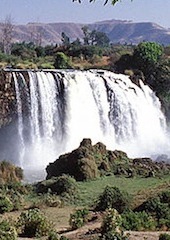Is It Time for Ethiopia?
Can Ethiopia resolve its differences with its Nile neighbors to share precious water?
December 26, 2013

In 1985, Egyptian diplomat and eventual UN Secretary General Boutros Boutros-Ghali famously commented that the next wars would not be over oil, but over water. Indeed, potentially explosive water conflicts are visible in most of the planet.
Due to population increase, climate change and territorial disputes, the global water situation will become greatly exacerbated. This danger is especially present, indeed alarming, in the Nile region, specifically with regard to relations between Ethiopia and Egypt.
To understand the current situation and future prospects, it is critical to recognize that tensions over the river Nile between Ethiopia and Egypt have deep roots in history.
However, it seems that the issue has escalated in the past few years, after Ethiopia decided on its ambitious plan to build the largest dam, also known as the Grand Renaissance Dam Project, for hydropower in the region.
Egypt’s civilization was always firmly centered on the river Nile and so is its future. The existence of Egypt would be unthinkable without the Nile.
Herodotus, the ancient Greek historian said that Egypt was the ‘ gift of the Nile’. This just underscores how historically important this river is, not only for Egypt, but to all seven countries that are dependent on Nile.
A lengthy dispute
The origins of the current Nile water tension can be traced back to 640 C.E during a period of turmoil Egypt’s conversion to Islam. Ethiopia took advantage of the arising turbulence and gained control of the Nile.
Much later, during the period of explorations of the European seaborne empires, in the 16th century, Portuguese settlers developed plans to divert the Nile water to the Red Sea by constructing a tunnel. However, this plan did not come to fruition.
Still, the mere fact that there was such a plan resulted in the creation of even bigger animosity between Egypt and Ethiopia.
Yet later, during the colonial era, Britain annexed Egypt in 1882. Meanwhile, Ethiopia successfully resisted Italian colonization at the epic Battle of Adwa in March 1896.
However, the period of colonial rule created several small states in the Nile valley (Eritrea, Uganda, Rwanda, Burundi, Kenya and Tanganyika). These smaller states carved out of the Nile valley later on became competitors for the resources around the Nile.
At the time of Egypt’s independence in 1922, the Nile Water Agreement of 1929 allowed Egypt a veto power over any water management project on the Nile. During this time, the Ethiopian monarch was not even consulted.
Under the leadership of Gamal Abdel Nasser, Egypt signed the Nile Water Agreement with Sudan, which resulted in the two countries controlling around 99% of the water from the Nile.
The agreement led to the creation of massive dams on the Nile, for instance the Aswan High Dam, the Roseires Dam and the Khasm al-Girba Dam. Such arrangements, of course, negatively affected the countries which were upstream.
Emperor Haile Selassie, highly offended at the move by Egypt to exclude Ethiopia from the Nile, negotiated the separation of the Ethiopian Orthodox Church from the Orthodox Church in Alexandria.
In retaliation, Egypt’s Nasser encouraged Muslims from Eritrea to secede from Ethiopia. Nasser also provided support for Muslim Somalis to wage their war of liberation in the Ogaden region of Ethiopia.
Although Ethiopia thwarted the Somalis, the war with Eritrea had devastating consequences for 30 years. It culminated with the overthrow of Haile Selassie and the eventual independence of Eritrea in 1993. That cut off Ethiopia’s access to the sea.
Drought and famine
In the 1980s, Ethiopia was in the grip of a massive famine stemming from poor rainfall and the quasi-fascist policies of Haile Mariam Mengistu. Egypt, too, was on the brink of a drought crisis when turbines in the Aswan High Dam failed, exposing Egypt’s dangerous over reliance on the dam.
Such catastrophes were followed by a small period of mutual understanding between Mengistu and Hosni Mubarak. But this period was short-lived. Mubarak embarked upon efforts to build the Toshka Canal, one of the world’s most expensive canals. Its effect was further dependence on, and exploitation of Nile waters.
Such unilateral actions on the part of the Egyptians led to further animosity over the years in the minds of the Ethiopians. Devoid of water that is essential for Ethiopia, an angered President Meles Zenawi began plans for the construction of the Grand Renaissance Dam in 2011.
Unsuccessful mediation efforts
International law on water has not been able to resolve this ongoing dispute over Nile waters. The Helsinki Agreement of 1966 and the United Nations Convention on the Law of Non-Navigational Uses of International Watercourses have suggested the idea of “equitable shares.”
This concept was applied in the Nile Basin Initiative of 1999. However, the countries of the Nile Valley failed to resolve the conflict, Egypt and Sudan claimed historic rights over the river, while the upstream states claiming for equitable shares.
In 2010, the other upstream countries signed a joint Cooperative Framework Agreement which sought for more water share for these countries. Egypt and Sudan appear to have rejected the agreement, though this remains to be clarified.
Drawbacks of dam-building
Constructing dams to satisfy one’s water requirements is not a new phenomenon and can have unforeseen consequences. Ethiopia, like many countries before, now has to weigh these considerations carefully before embarking on its dam building spree.
History provides us various examples which would advise caution. Environmental degradation and damage to the eco system is one certainty worth considering now.
The Aswan High Dam and various other dams built or being built in China have had tremendous consequences on the environment. Ethiopia stands to lose the most due to climate change in light of its ever expanding population, set to double by 2050.
Second, creation of dam projects as a solution for one country almost always has negative ramifications on others.
The U.S. Hoover Dam on the Colorado River restricted water supply to Mexico. The Aswan High Dam in Egypt has restricted supply of water in upstream countries of the Nile; and China’s scramble to build more dams has caused concerns of water security in South and East Asia.
Dams are an obvious necessity, however countries must weigh the cost benefits of such economic projects with that of sustainable development, particularly its future impacts. Development today, is also about balancing ‘how we survive our common future‘ with ‘improving our past.’
Such phenomena can have disastrous effects on state relations and increase the potential and propensity of regional conflicts.
Despite past injustices, Ethiopia must realize that in fragile security systems, its destiny is tied to others. A more sustainable solution would be to put more effort in engaging other countries dependent on the Nile: Nile water issues transcend politics and are deeply rooted in history, religion and identity.
Will Ethiopia compete or cooperate on Nile water? It remains to be seen. The country sees itself in a cycle of ascendance, while Egypt is in deep trouble, politically, economically and socially. Such dynamism doesn’t augur well for a constructive solution.
Takeaways
Tensions over the river Nile between Ethiopia and Egypt have deep roots in history.
Egypt’s civilization was always firmly centered on the river Nile and so is its future.
The current Nile water tension can be traced back to 7th century turmoil during Egypt’s conversion to Islam.
International law on water rights has not been able to resolve this ongoing dispute over Nile waters.
Creation of dam projects as a solution for one country almost always has negative ramifications on others.
Ethiopia sees itself on the rise, while Egypt is in deep trouble, politically, economically and socially.
Despite past injustices, Ethiopia must realize that in fragile security systems, its destiny is tied to others.

